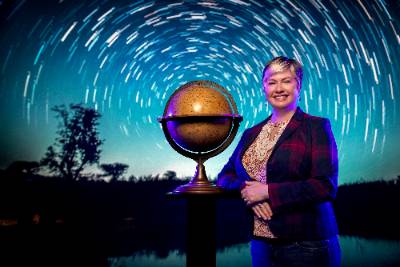Natalie Hinkel
Assistant Professor of Physics & Astronomy
Ph.D., 2012 - Arizona State University
Louisiana State University
Department of Physics & Astronomy
261B Nicholson Hall, Tower Dr.
Baton Rouge, LA 70803-4001
225-578-7806
nhinkel@lsu.edu
Research Interests
Topics: Stellar elemental abundances, Exoplanet interiors and mineralogy, M-dwarfs, Balloon Instrumentation, Machine learning, Interdisciplinary study of planetary habitability
Stars are large furnaces with high enough internal pressures and temperatures for atomic fusion, such that most of the elements in the Periodic Table were formed within stars across many generations. The composition of stars, including the Sun, can be determined by looking at the atomic or molecular absorption lines within their spectra and measuring the overall amount or abundance of the elements. I have put together the largest database of elemental abundances for FGKM-type stars near to the Sun (or within 500 pc) called the Hypatia Catalog. The Hypatia Catalog is made up of hundreds of datasets observed by a variety of different teams, meaning it is also a multidimensional database. The breadth (number of stars) and depth (number of elements) of data within the Hypatia Catalog makes it uniquely useful for analyzing broad stellar abundance patterns within the galaxy, between stars with and without planets, and when using different stellar abundance techniques. The shear also provides an excellent opportunity for applying machine learning algorithms.
Many of the stars within the Hypatia Catalog are known to host exoplanets, or planets outside of our Solar system. It's important to understand the composition, interior structure, and mineralogy of a planet -- especially small, Earth-sized planets -- since these properties play a major role in the habitability of a planet. Unfortunately, we don't currently have the technological capability to measure the interior make-up of exoplanets. However, stars and planets are formed at the same time and from the same material -- meaning we can use the composition of the host star as a proxy for the planet. This work involves collaborating with other interdisciplinary scientists who study geology, (astro)biology, and planets within the Solar system.
Red M-dwarf stars are the next best place to observe Earth-sized planets, since it's easier to detect small planets around smaller stars. However, it's very difficult to measure the abundances of M-dwarfs because their spectra are best observed in the infrared, which is unfortunately blocked by all of the H2O and CO2 within the Earth's atmosphere. Therefore, I am leading a balloon mission proposal to build and fly an infrared spectrograph around Antarctica in order to measure key abundances in M-dwarfs: the Spectroscopic Abundances to Know the Heritage of M-dwarf Environs through Time (SAKHMET) mission. SAKHMET will double the number of characterized M-dwarfs while quadrupling the number of individual abundance measurements, truly revolutionizing the field.
Selected Publications
- Editors: Hinkel, Natalie R., Putirka, Keith D., Xu, Siyi. Reviews in Mineralogy and Geochemistry vol 90: Exoplanets: Compositions, Mineralogy, Evolution, 2024. Available on Amazon.
- Hinkel, Natalie R., Timmes, F.X., Young, P.A., Pagano, M.D., and Turnbull, M. C. Analyzing the Stellar Abundances in the Solar Neighborhood: The Hypatia Catalog, 2014, AJ, 148, 54
- Hinkel, Natalie R., Hartnett, H., Young, P. A. The Influence of Stellar Phosphorus On Our Understanding of Exoplanets and Astrobiology, 2020, 900, L38
- Hinkel, Natalie R., Unterborn, C., Kane, S.R., Somers, G., and Galvez, R., A Recommendation Algorithm to Predict Giant Exoplanet Host Stars Using Stellar Abundances, 2019, ApJ, 880, 1
- Hinkel, Natalie R., Young, P.A., & Wheeler, C.H. A Concise Treatise on Converting Stellar Mass Fractions to Abundances to Molar Ratios, 2022. AJ, 164, 256
- Hinkel, Natalie R., Young, P.A., Pagano, M., Desch, S.J., Anbar, A.D., Adibekyan, V., Blanco-Cuarsema, S., Carlberg, J., Delgado Mena, E., Liu, F., Nordlander, T., Sousa, S.G., Korn, A., Gruyters, P., Heiter, U., Jofré, P., Santos, N.C., Soubiran, C., A Comparison of Stellar Elemental Abundance Techniques and Measurements, 2016, ApJS, 226, 4
- Shorttle, O., Hinkel, Natalie R., Unterborn, C., Why Geosciences and Exoplanetary Sciences Need Each Other, 2021, Elements Magazine v17, 4, 1
- Hinkel, Natalie R. & Unterborn, C.T., The Star-Planet Connection I: Using Stellar Composition to Observationally Constrain Planetary Mineralogy for the Ten Closest Stars, 2018, ApJ, 853, 1
- Hinkel, Natalie R. & Kane, S.R., Habitability of Exomoons at the Hill or Tidal Locking Radius, 2013, ApJ, 774, 27